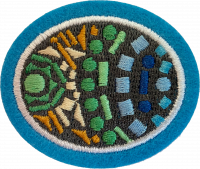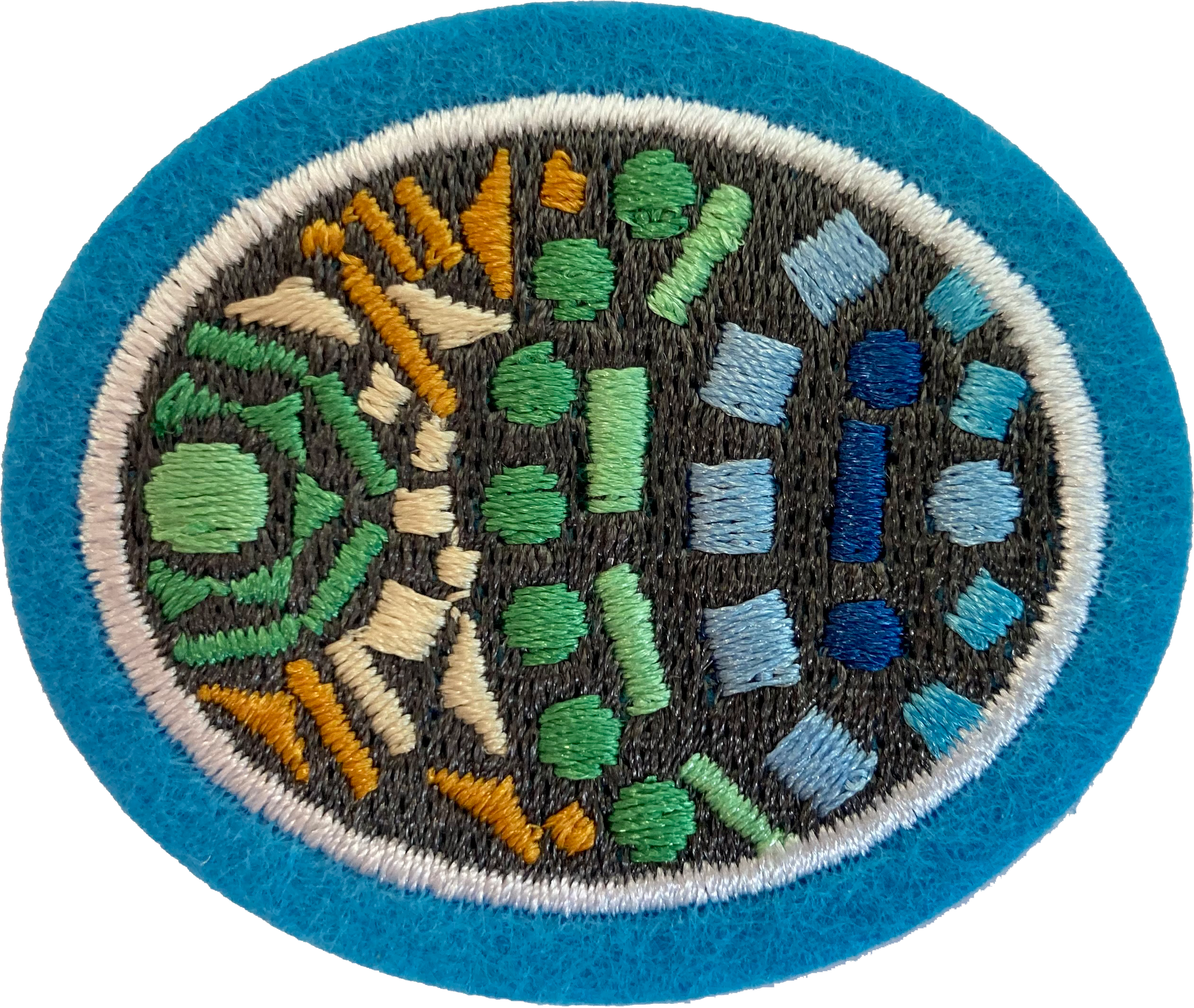Difference between revisions of "AY Honors/Mosaic Tile/Answer Key/es"
From Pathfinder Wiki
< AY Honors | Mosaic TileAY Honors/Mosaic Tile/Answer Key/es
(Created page with "{{clear}}") |
(Updating to match new version of source page) |
||
| (14 intermediate revisions by 2 users not shown) | |||
| Line 1: | Line 1: | ||
| − | + | {{HonorSubpage}} | |
| − | |||
| − | |||
| − | {{ | ||
| − | |||
| − | |||
| − | |||
| − | |||
| − | |||
| − | |||
| − | |||
| − | }} | ||
| − | |||
| − | |||
| − | |||
<section begin="Body" /> | <section begin="Body" /> | ||
{{ansreq|page={{#titleparts:{{PAGENAME}}|2|1}}|num=1}} | {{ansreq|page={{#titleparts:{{PAGENAME}}|2|1}}|num=1}} | ||
| Line 41: | Line 27: | ||
{{ansreq|page={{#titleparts:{{PAGENAME}}|2|1}}|num=2}} | {{ansreq|page={{#titleparts:{{PAGENAME}}|2|1}}|num=2}} | ||
<noinclude></noinclude> | <noinclude></noinclude> | ||
| − | <!-- 2. | + | <!-- 2. ¿De qué tipo de material está hecho comúnmente los azulejos? --> |
{{clear}} | {{clear}} | ||
| Line 49: | Line 35: | ||
{{ansreq|page={{#titleparts:{{PAGENAME}}|2|1}}|num=3}} | {{ansreq|page={{#titleparts:{{PAGENAME}}|2|1}}|num=3}} | ||
<noinclude></noinclude> | <noinclude></noinclude> | ||
| − | <!-- 3. | + | <!-- 3. ¿Cuál es la diferencia entre los azulejos esmaltados y no esmaltados? --> |
{{clear}} | {{clear}} | ||
| Line 65: | Line 51: | ||
{{ansreq|page={{#titleparts:{{PAGENAME}}|2|1}}|num=4}} | {{ansreq|page={{#titleparts:{{PAGENAME}}|2|1}}|num=4}} | ||
<noinclude></noinclude> | <noinclude></noinclude> | ||
| − | <!-- 4. | + | <!-- 4. ¿Cuál es la diferencia entre la lechada con y sin arena? ¿En qué aplicaciones se usa cada tipo? --> |
{{clear}} | {{clear}} | ||
| Line 81: | Line 67: | ||
{{ansreq|page={{#titleparts:{{PAGENAME}}|2|1}}|num=5}} | {{ansreq|page={{#titleparts:{{PAGENAME}}|2|1}}|num=5}} | ||
<noinclude></noinclude> | <noinclude></noinclude> | ||
| − | <!-- 5. | + | <!-- 5. Nombrar tres herramientas comúnmente utilizadas para la instalación de azulejos. --> |
| − | + | {{clear}} | |
| − | |||
| − | |||
| − | |||
| − | |||
| − | |||
| − | |||
| − | |||
| − | |||
| − | |||
| − | |||
<noinclude></noinclude> | <noinclude></noinclude> | ||
| Line 99: | Line 75: | ||
{{ansreq|page={{#titleparts:{{PAGENAME}}|2|1}}|num=6}} | {{ansreq|page={{#titleparts:{{PAGENAME}}|2|1}}|num=6}} | ||
<noinclude></noinclude> | <noinclude></noinclude> | ||
| − | <!-- 6. | + | <!-- 6. Realizar las siguientes actividades: --> |
<noinclude></noinclude> | <noinclude></noinclude> | ||
| Line 119: | Line 95: | ||
{{ansreq|page={{#titleparts:{{PAGENAME}}|2|1}}|num=7}} | {{ansreq|page={{#titleparts:{{PAGENAME}}|2|1}}|num=7}} | ||
<noinclude></noinclude> | <noinclude></noinclude> | ||
| − | <!-- 7. | + | <!-- 7. Describir cómo aplicar correctamente la lechada. --> |
| − | + | {{clear}} | |
<noinclude></noinclude> | <noinclude></noinclude> | ||
| Line 127: | Line 103: | ||
{{ansreq|page={{#titleparts:{{PAGENAME}}|2|1}}|num=8}} | {{ansreq|page={{#titleparts:{{PAGENAME}}|2|1}}|num=8}} | ||
<noinclude></noinclude> | <noinclude></noinclude> | ||
| − | <!-- 8. | + | <!-- 8. Describir cómo sellar adecuadamente y terminar un proyecto de mosaico. --> |
<noinclude></noinclude> | <noinclude></noinclude> | ||
| Line 133: | Line 109: | ||
{{ansreq|page={{#titleparts:{{PAGENAME}}|2|1}}|num=9}} | {{ansreq|page={{#titleparts:{{PAGENAME}}|2|1}}|num=9}} | ||
<noinclude></noinclude> | <noinclude></noinclude> | ||
| − | <!-- 9. | + | <!-- 9. Completar un proyecto de mosaico como un salvamanteles, agarraderas de cocina u otros artículos domésticos. El artículo debe ser de por lo menos 6” por 6” (15.25 cm por 15.25 cm). --> |
<noinclude></noinclude> | <noinclude></noinclude> | ||
{{CloseReq}} <!-- 9 --> | {{CloseReq}} <!-- 9 --> | ||
| − | |||
| − | |||
| − | |||
| − | |||
| − | |||
| − | |||
<noinclude></noinclude> | <noinclude></noinclude> | ||
| − | < | + | ==Referencias==</noinclude> |
| + | {{CloseHonorPage}} | ||
Latest revision as of 16:12, 14 July 2022
Azulejos de mosaico
Nivel de destreza
1
Año
2020
Version
30.12.2025
Autoridad de aprobación
División Norteamericana
1
Dar una breve historia de los azulejos.
1a
¿Cuándo se usaron por primera vez?
1b
¿Cuáles fueron dos usos comunes a lo largo de la historia?
2
¿De qué tipo de material está hecho comúnmente los azulejos?
3
¿Cuál es la diferencia entre los azulejos esmaltados y no esmaltados?
4
¿Cuál es la diferencia entre la lechada con y sin arena? ¿En qué aplicaciones se usa cada tipo?
5
Nombrar tres herramientas comúnmente utilizadas para la instalación de azulejos.
6
Realizar las siguientes actividades:
6a
Nombrar dos herramientas comúnmente utilizadas para cortar azulejos.
6b
Demostrar la capacidad de cortar azulejos con una de estas herramientas.
7
Describir cómo aplicar correctamente la lechada.
8
Describir cómo sellar adecuadamente y terminar un proyecto de mosaico.
9
Completar un proyecto de mosaico como un salvamanteles, agarraderas de cocina u otros artículos domésticos. El artículo debe ser de por lo menos 6” por 6” (15.25 cm por 15.25 cm).


